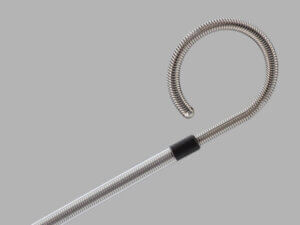Bloomington, Ind. — The British Journal of Urology International Compass published a health economics model showing the benefits of Cook Medical’s Resonance® Metallic Ureteral Stent when used as a first-line treatment option for extrinsic malignant ureteric obstruction (MUO). The research demonstrates that the stent is a win for both health systems and patients: the stent is more cost-effective than standard polyurethane ureteral stents, as well as offering several health benefits to patients.
This newly published health economic analysis sought to assess whether the use of polyurethane double-J (JJ) stents or the Resonance metallic stent is more cost-effective for managing extrinsic MUO in the UK healthcare setting. Malignant ureteral obstruction is a frequent challenge for urologists. Patients with MUO have poor prognoses, and treatment usually aims to improve quality of life while optimising renal function.
Currently, the standard practice is to treat MUO using polyurethane stents, which require frequent surgical replacements due to blockages and encrustation. Metallic stents are more durable, but they have a higher initial purchase price, which makes healthcare systems wary of them. This ecomomic report shows that even though metallic stents have a higher up-front cost, they tend to be more cost-effective over time. Here are some of the cost benefits that the report showed:
- Use of the Resonance stent is likely to result in between a £726- £1075 saving per patient within year 1.1
- Treatment of MUO with Resonance incurs 23.4% less overall treatment costs than polyurethane stents over 5 years.1
- By removing unnecessary, unplanned surgical re-intervention, the use of Resonance may free up surgical capacity for the elective provision and reduce the burden on the emergency readmission due to stent failure.1
In addition to demonstrating that the Resonance stent is cost-effective, the report also showed several health benefits to patients. While it is important to consider affordability and healthcare economics, the main goal of treatment is improving the quality of life for the patient. The report showed the following patient benefits:
- Resonance use in MUO predicts 2 fewer surgical interventions within 1 year per patient.1
- Patients experienced increased quality of life due to reduced stent failure and the associated pain and impact of further surgical intervention.1
- Resonance stents increase the functional duration by 4 months2 and have a lower risk of stent failure.1
- Physicians and patients who used the Resonance stent avoided stent exchanges needed due to failure or encrustation. Stent exchange can be technically difficult, may fail, can cause complications with added morbidity, and may itself further compromise the patient’s quality of life.3 4
“We want to show physicians that investing in higher-quality medical devices is worth it,” said Johan Lowinger, director of product management for Cook’s Urology specialty. “Research like this is about more than just data; it’s about the rethinking the implications of treatment plans, physician practices and patient outcomes. When we prioritize patient health and put people first, it’s a win-win situation for everyone involved: patients, physicians and health systems alike.”
To learn more about the Resonance Metallic Ureteral Stent, you can view product details here.
About Cook Medical
Since 1963, Cook Medical has worked closely with physicians to develop technologies that eliminate the need for open surgery. Today we invent, manufacture, and deliver a unique portfolio of medical devices to the healthcare systems of the world. Serving patients is a privilege and we demand the highest standards of quality ethics, and service. We have remained family owned so that we have the freedom to focus on what we care about: our patients, our employees, and our communities.
Find out more at CookMedical.eu, and for the latest news, follow us on Twitter, Facebook and LinkedIn.
1 Cooper DM, Lines R and Shergill I. Cost-Effectiveness of Resonance® metallic ureteral stent compared with standard polyurethane ureteral stents in malignant ureteric obstruction: a cost-utility analysis. BJUICompas 2024; Volume issues page number and doi TBC.
2 Chow PM, Chiang IN, Chen CY, Huang KH, Hsu JS, Wang SM, et al. Malignant Ureteral Obstruction: Functional Duration of Metallic versus Polymeric Ureteral Stents. PLoS One. 2015/08/13. 2015;10(8):e0135566.
3 Khoo CC, Abboudi H, Cartwright R, El-Husseiny T, Dasgupta R. Metallic Ureteric Stents in Malignant Ureteric Obstruction: A Systematic Review. Urology. 2018 Aug;118:12–20.
4 Sountoulides P, Kaplan A, Kaufmann OG, Sofikitis N. Current status of metal stents for managing malignant ureteric obstruction. BJU Int. 2010 Apr;105(8):1066–72.
